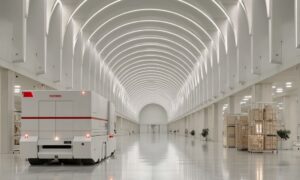10 Game-changing innovations revolutionizing urban warfare
Urban warfare, characterized by combat within densely populated cities and towns, presents unique challenges that differ significantly from traditional battlefield environments. The complexities of fighting in urban settings include navigating through tight spaces, dealing with civilian populations, and operating in environments with numerous physical obstacles. As urban areas become the primary battlegrounds for modern military conflicts, technological advancements and innovative strategies are reshaping how these battles are fought. This article explores ten key innovations that are changing the face of urban warfare.
1. Unmanned Aerial Vehicles (UAVs) and Drones
Unmanned Aerial Vehicles (UAVs), commonly known as drones, have become a game-changer in urban warfare. These small, agile devices can be deployed quickly to provide real-time intelligence, surveillance, and reconnaissance (ISR) capabilities. Equipped with high-definition cameras, thermal imaging, and advanced sensors, drones can monitor enemy movements, identify threats, and provide commanders with a bird’s-eye view of the battlefield.
Drones are particularly useful in urban environments where traditional surveillance methods are limited by buildings and infrastructure. They can enter narrow alleys, hover above high-rise buildings, and provide precise targeting data for airstrikes or ground operations. Furthermore, drones can be equipped with weapons, allowing them to engage targets directly, reducing the risk to human soldiers. Their versatility and ability to operate in constrained spaces make them indispensable tools in modern urban combat scenarios.
2. Robotics and Autonomous Systems
The use of robotics and autonomous systems is rapidly transforming urban warfare. Ground-based robots, equipped with cameras, sensors, and sometimes even weapons, are being used for reconnaissance, bomb disposal, and direct engagement with enemy forces. These robots can navigate through debris, enter buildings, and operate in hazardous environments where human soldiers would be at significant risk.
Autonomous systems are also being developed to support logistics, such as delivering supplies to soldiers in contested areas or evacuating casualties. The deployment of autonomous vehicles for resupply missions reduces the risk to human personnel and ensures that critical supplies reach the front lines on time. As robotic technology continues to advance, we can expect to see even more sophisticated machines capable of complex tasks, such as breaching buildings or clearing obstacles in urban combat zones.
3. Augmented Reality (AR) and Virtual Reality (VR) Training
Training for urban warfare is challenging due to the unpredictable nature of city environments and the presence of civilians. Augmented Reality (AR) and Virtual Reality (VR) technologies are revolutionizing military training by providing realistic, immersive simulations that prepare soldiers for the complexities of urban combat.
AR and VR training programs enable soldiers to practice tactical maneuvers, communication, and decision-making in lifelike virtual environments. These simulations can replicate the chaos of urban warfare, complete with realistic sounds, visual effects, and dynamic scenarios. Soldiers can be trained to navigate buildings, handle civilian interactions, and respond to ambushes, all in a controlled and safe environment. This type of training is invaluable in preparing military personnel for the challenges of real-world urban conflicts.
4. Artificial Intelligence (AI) for Tactical Decision-Making
Artificial Intelligence (AI) is playing an increasingly important role in urban warfare by enhancing tactical decision-making. AI algorithms can analyze vast amounts of data from multiple sources, such as drones, surveillance cameras, and social media to provide commanders with actionable intelligence. AI systems can identify patterns, predict enemy movements, and suggest optimal strategies based on the data collected.
AI is also being used to improve situational awareness on the battlefield. For example, AI-powered systems can detect threats in real time, such as identifying the presence of snipers or IEDs (Improvised Explosive Devices) in the urban landscape. By providing timely and accurate information, AI helps military personnel make informed decisions, reducing the risk of casualties and increasing the likelihood of mission success.
5. Cyber Warfare Capabilities
Cyber warfare is an increasingly important component of modern urban combat. In urban environments, digital networks, both civilian and military, are often interconnected, providing opportunities for cyber attacks to disrupt enemy operations. Cyber warfare capabilities can be used to disable enemy communications, disrupt supply chains, and manipulate public information to create confusion and panic.
The ability to launch cyber attacks against critical infrastructure, such as power grids, water supplies, and transportation systems, gives military forces a significant strategic advantage. Moreover, cyber warfare can be used defensively to protect friendly networks from enemy intrusion and to maintain secure lines of communication. As cyber capabilities continue to evolve, they will play an even more crucial role in shaping the outcomes of urban conflicts.
6. Smart Munitions and Precision-Guided Weapons
Smart munitions and precision-guided weapons are changing the way urban warfare is conducted by minimizing collateral damage and increasing the effectiveness of strikes. These weapons are equipped with advanced guidance systems that enable them to hit specific targets with high accuracy, even in densely populated areas.
For instance, laser-guided bombs, GPS-guided missiles, and smart artillery shells can be directed to strike enemy positions while avoiding civilian structures. This precision reduces the risk of unintended casualties and damage to infrastructure, which is critical in urban warfare where civilians are often present. The use of smart munitions also allows for more surgical strikes, making it possible to neutralize high-value targets with minimal collateral impact.
7. Urban Combat Exoskeletons
Urban combat exoskeletons are wearable devices designed to enhance the physical capabilities of soldiers in challenging environments. These exoskeletons are equipped with motors, sensors, and hydraulic systems that provide additional strength, endurance, and mobility to the wearer. In urban warfare, where soldiers must navigate through rubble, climb stairs, and carry heavy loads, exoskeletons can significantly improve operational efficiency.
Exoskeletons can also reduce fatigue and injury, allowing soldiers to perform their duties for extended periods. Some exoskeletons are designed to provide ballistic protection, reducing the risk of injury from gunfire and explosions. As exoskeleton technology advances, it will become an essential tool for enhancing the capabilities of soldiers in urban combat scenarios.
8. Advanced Surveillance and Reconnaissance Systems
Surveillance and reconnaissance are critical components of urban warfare, where the ability to gather and analyze information can determine the success or failure of a mission. Advanced surveillance systems, including high-resolution cameras, facial recognition software, and biometric scanners, are being deployed to monitor urban areas in real time.
These systems are capable of identifying potential threats, tracking enemy movements, and providing intelligence on the local population. For example, facial recognition technology can be used to identify suspects in a crowd, while biometric scanners can detect the presence of known militants. By enhancing situational awareness, these systems help military forces make informed decisions and respond quickly to emerging threats.
9. Communication and Networking Technologies
Effective communication is essential in the complex, fast-paced environment of urban warfare. Modern communication and networking technologies are enabling seamless coordination between units, even in environments where traditional communication channels are disrupted.
Mesh networks, for instance, allow for the creation of decentralized, resilient communication networks that can operate without relying on central infrastructure. These networks enable soldiers to maintain communication even if parts of the network are damaged or destroyed. Additionally, advanced encryption technologies ensure that communications remain secure from enemy interception.
The use of satellite communication, drones, and mobile devices equipped with secure communication apps also enhances the ability of military units to coordinate their actions, share intelligence, and adapt to rapidly changing situations on the ground.
10. Urban Warfare Drones for Logistics and Medical Support
Beyond their use for reconnaissance and combat, drones are increasingly being deployed for logistics and medical support in urban warfare. Logistics drones can deliver supplies such as food, water, ammunition, and medical equipment to soldiers on the front lines, reducing the risk associated with traditional supply convoys.
Medical drones can be used to evacuate casualties from the battlefield, providing rapid transport to medical facilities. In situations where roads are blocked or infrastructure is damaged, drones can reach areas that would otherwise be inaccessible. By improving logistical efficiency and medical support, drones help sustain military operations and save lives in urban combat zones.
Urban warfare presents unique challenges that require innovative solutions. The ten innovations highlighted in this article, UAVs, robotics, AR/VR training, AI, cyber warfare capabilities, smart munitions, exoskeletons, advanced surveillance systems, communication technologies, and drones are transforming the way military forces operate in cities. These technologies enhance situational awareness, improve decision-making, and increase operational efficiency, ultimately changing the face of urban warfare. As these innovations continue to evolve, they will shape the strategies and tactics used in future conflicts, making urban warfare more precise, efficient, and potentially less destructive.



































